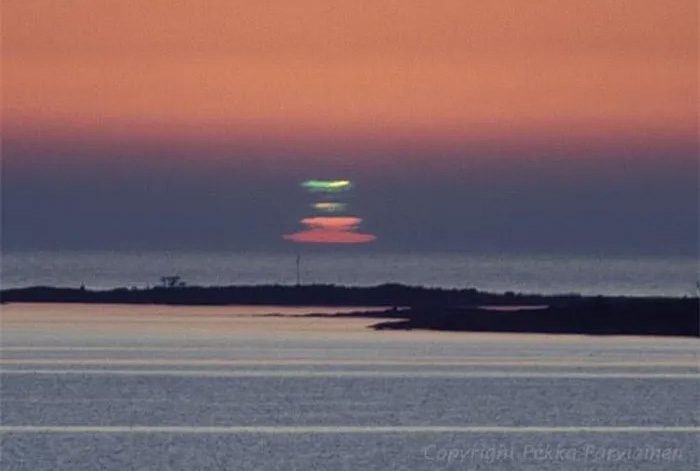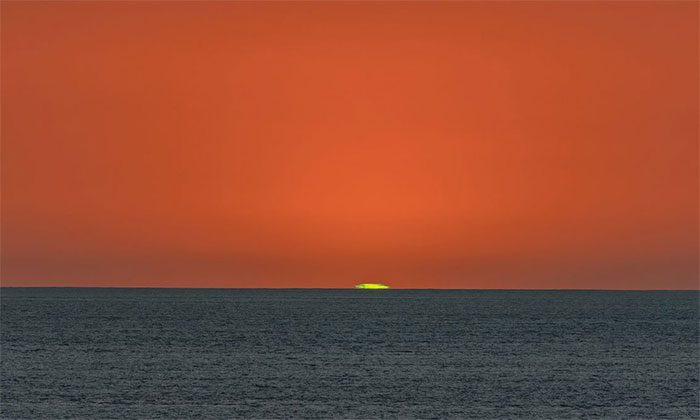The Green Flash is an optical phenomenon that occurs just after sunset or just before sunrise. Observers will see a green point (green) appearing for about 1 or 2 seconds right above the horizon of the Sun, or it may look like a green beam of light shooting up from the point where the Sun sets. The Green Flash can also appear when the Moon or bright planets like Venus and Jupiter rise or set at the horizon.
The Green Flash can be observed from any altitude (even from an airplane). This phenomenon is often seen in locations where the view to the horizon is unobstructed, such as over the sea.

The Green Flash is essentially an optical phenomenon.
The primary cause of the Green Flash phenomenon is that sunlight (white light) refracts as it passes through the Earth’s atmosphere, depending on the wavelength of the light, and separates into spectral colors. Blue light is refracted the most, followed by green, yellow, and red.
When the Sun sets and is still about 1/60 of the diameter of the Sun above the horizon, one can observe the Sun’s edges changing color from red to blue. When the red edge followed by the yellow disappears, the green and blue edges remain at the horizon; however, blue light is scattered significantly in the atmosphere, making it difficult to see. Only the green color (which lies between yellow and blue in the spectrum) remains and is usually seen for a few seconds.
The Earth’s atmosphere, with its varying gas densities, can also refract light. This is why one sometimes sees rainbow halos around the Sun or distant mirages, according to Jan Null, a meteorologist in California. Refraction becomes very evident when the Sun approaches the horizon because sunlight is entering the thickest part of the atmosphere at a very narrow angle. This is when the Green Flash can appear.
Most Green Flashes can be classified into two types. The first type appears just before the Sun disappears. However, the type that Null encounters more frequently is when the Sun is still above the water. “You will see this flash on the upper rim of the Sun’s disk,” he says.
However, under favorable conditions, one can also observe blue or even purple flashes.

The green flash can occur when the Sun sets over the sea. (Photo: David McManus).
To see the Green Flash, observers need to meet the right conditions. First, they must see the Sun when it is close to the horizon, for example, on a beach or from a high mountain, according to Courtial. Null indicates that in coastal areas like San Francisco, the chances of seeing the Green Flash are higher on warm days when there is a layer of warm air above the cold water. These layers of air help refract sunlight.
Observing the Green Flash also depends on atmospheric substances. Particles can scatter blue and violet light, making the green light more apparent. Courtial demonstrates this with a simple experiment: adding milk powder to a tank filled with water and shining a white bicycle light into it. “When you add the right concentration of particles, you will see a brilliant green color,” he says.
Additionally, to see the Green Flash, observers should do so on a clear day, when the Sun can be viewed unobstructed. However, it is important to note that one should not look directly at the Sun without eye protection.
The Green Flashes usually last less than a second. But if one is lucky, they might see them for one or two minutes. Null also rarely observes this, even after 45 years of studying the Green Flash. He states that the Green Flash can persist if atmospheric conditions are stable enough.




















































